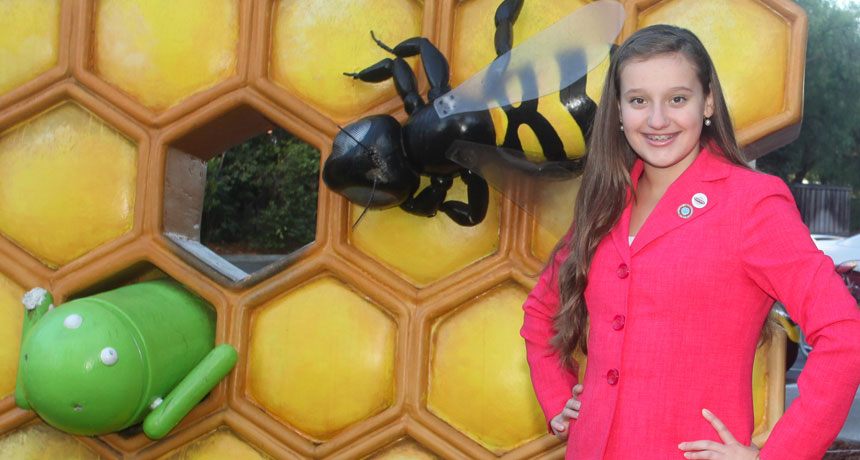Student devises test to catch cheaters
A teen finds students cheat more than you might think

Evelyn Bodoni came to the Broadcom MASTERS to spread the buzz about cheating in schools.
E. Nguyen/SSP
SAN JOSE, Calif. — No one likes a cheater. Evelyn Bodoni, 13, certainly doesn’t. But when she saw academic dishonesty and complained, her teachers said they couldn’t take action. They only had Evelyn’s word that there was a problem. They needed more evidence. So the teen took this as a challenge. She developed a research project to test how likely students were to cheat — and under what circumstances.
The eighth grader at Challenge School in Denver, Colo., presented her eye-opening findings at a competition here called Broadcom MASTERS (for Math, Applied Science, Technology and Engineering for Rising Stars). It’s sponsored by Broadcom, a company that builds devices to help computers connect to the Internet.
This annual program was created by the Society for Science & the Public. The competition brings together students with winning middle-school science-fair projects from across the United States. Finalists shared their work with each other and the public here on October 3.
“Cheating is detrimental because it affects not only the students [who cheat] but the students around them,” Evelyn says. She decided to find out just how commonly students cheat on tests. To do that, she recruited 68 student volunteers. All were in grades five through eight.
She administered a difficult 10-question, multiple-choice test to each. The answers were clearly written on the back of the paper. Evelyn led the students in groups into a room to take their test. Then, she left them unsupervised as each group answered the questions.
But here’s the twist — and where the science comes in. The groups were not really treated quite the same way. One group was offered a reward — a pen that had several fun colors — to anyone who got 80 percent of the questions right. In two other groups, she planted decoy to exert peer pressure on the test-takers. In one group, that person might say: “Oh, she’s gone. But don’t cheat!” If another student in the group tried to ask for an answer, the decoy might say “we can’t talk about it, it’s a test!” In the other group, the decoy encouraged cheating. Explains Evelyn, “The person would say ‘Yes, she’s gone! What’d you get for number 3?’” Or they might make a big show of flipping over the paper and looking on the back to see what the answers were.
The last group was her control — that part of the experiment where nothing was changed. Here, the students just took the test with no incentives or comments from others.
As they filled out their answers, all groups were being observed by someone they couldn’t see. Evelyn’s father was sitting in an observation room. He did not know any of the students, so he should not be biased — or have a preference — for any one student over another. He witnessed and tallied how many students cheated in each group.
When promised a reward, a whopping 81 percent of the students cheated, Evelyn found. Even without a reward, 69 percent looked at the answers when a decoy encouraged cheating. But the share of cheating dropped to just 19 percent when a decoy advocated honesty.
But the “sad” news, Evelyn says, was that even 40 percent of her control group cheated.
The teen can think of many reasons for much of the dishonesty she turned up. “Reward is a strong motivation,” she notes. And the groups with a decoy may have been tempted by peer pressure. The real mystery is why so many cheated in the control group. Their score “didn’t even count toward a grade in school. But they still [cheated].”
Evelyn knows that her experiment may not show what every school, or even every test, is really like. After all, this test wasn’t worth any class credit, and there was no authority figure in the room — such as a teacher — to police the teens’ behavior. So students might not have taken the test as seriously as they might for a real class. The young researcher also notes that these results might differ from what would take place at other schools.
But the teen is also optimistic that her study might offer clues to help prevent cheating. It appears kids listen to peers. So pressuring others to do the right thing may affect classroom behaviors, she says.
Evelyn hopes that her study will get the message across that plenty of students are willing to cheat. Now, she says, “We should do something about it. We should have methods [to prevent cheating] in place and have them enforced so students can see it’s not okay.”
Follow Eureka! Lab on Twitter
Power Words
(for more about Power Words, click here)
bias The tendency to hold a particular perspective or preference that favors some thing, some group or some choice. Scientists often blind subjects to the details of a test so that their biases will not affect the results.
peer Someone who is an equal, based on age, education, status, training or some other features.
reward (In animal behavior) A stimulus, such as a tasty food pellet, that is offered to an animal or person to get them to change their behavior or learn a task.